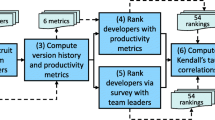Abstract
In order to calculate size and to estimate effort in applications, the standard method most usually used is function points, which has been used with good results in the development of industrial software for some time. However, some aspects should be improved, namely: the time at which the estimation of effort is performed and the margin of error in the effort estimation. Consequently, another size metric which could be used to obtain more accurate estimations should be found. This article presents two other size metrics for projects based on use cases: transactions and entity objects. Effort is estimated by using the technique mean productivity value. There is also a description of two case studies, one which involved four academic projects and the other one which involved four industrial projects. They were developed in order to compare the estimations obtained with each method. The result shows that the current way of estimating effort can be improved by using the number of transactions as a size metric and the technique mean productivity value.
Similar content being viewed by others
References
ISO/IEC 14143-1:1998 (1998) Functional size measurement. http://www.iso.org
Ruhe M, Jeffery R, Wieczorek I (2003) Using web objects for estimating software development effort for Web applications. In: Proceedings of the ninth international software metrics symposium, Sydney, Australia 3–5 September 2003, p 30
Kitchenham B (1997) Counterpoint: the problem with function points. IEEE Softw 14(2): 29
Lokan C (1999) An empirical study of the corelations betweeen function points elements. In: Proceedings of the 6th international symposium on software metrics, vol 200
Karner G (1993) Metrics for Objectory. Diploma Thesis, University of Linköping, Sweden
Anda B, Benestad H, Hove S (2005) A multiple-case study of effort estimation based on use case point. In: Fourth international symposium on empirical software engineering (ISESE’2005). IEEE Computer Society, Australia, November 17–18, pp 407–416
Harput V, Kaindl H, Kramer S (2005) Extending function points analysis to object-oriented requirements specifications. In: 11th IEEE international software metrics symposium, Como, Italy, September 19–22
Fetcke T, Abran A, Nguyen T (1997) Mapping the OO-Jacobson approach into function point analysis. Technol Object-Oriented Lang Syst Tools 23: 192–202
Uemura T, Kusumoto S, Inoue K (1999) Function points measurement tool for UML design specification. In: Proceedings of the sixth international software metrics symposium, Boca Raton
Smith J (1999) The estimation of effort based on use case. IBM Rational Software White Paper
Anda B, Angelvik E, Ribu K (2002) Improving estimation practices by applying use case models. Lect Notes Comput Sci 2559: 383–397
Vinsen K, Jamieson D, Callender G (2004) Use case estimation—the devil is in the detail. In: Proceedings of the requirements engineering conference, 12th IEEE International (RE’04), pp 10–15
Mohagheghi P, Anda B, Conradi R(2005) Effort estimation of use cases for incremental Large-scale Software development. In: Proceedings of the 27th international conference on Software engineering, pp 303–311
Braz M, Vergilio S (2006) Effort estimation based on use cases. In: 30th annual international computer software and applications conference (COMPSAC’06), pp 221–228
Issa A, Odeh M, Coward D (2006) Software cost estimation using use-case models: a critical evaluation. Inf Commun Technol 2: 2766–2771
Santillo L, Conte Mand Meli R (2005) Early & quick function point: sizing more with less. In: 11th IEEE international software metrics symposium, Como, September 19–22
Jacobson I, Christerson M, Jonsson P, Övergaard G (1992) Object oriented software engineering. Addison Wesley, Harlow
Fenton N, Pfleeger S (1997) Software metrics. PWS Publishing Company, Boston
Kitchenham B, Känsälä K (1993) Inter-item correlations among function points. International conference on software engineering proceedings of the 15th international conference on software engineering, Baltimore, pp 477–480
Kusumot S, Matukawa F, Inoue K, Hanabusa S, Maegawa Y (2004) Estimating effort by use case points: method, tool and case study. In: Proceedings of the 10th international symposium on software metrics
Author information
Authors and Affiliations
Corresponding author
Rights and permissions
About this article
Cite this article
Robiolo, G., Orosco, R. Employing use cases to early estimate effort with simpler metrics. Innovations Syst Softw Eng 4, 31–43 (2008). https://doi.org/10.1007/s11334-007-0043-y
Received:
Accepted:
Published:
Issue Date:
DOI: https://doi.org/10.1007/s11334-007-0043-y




